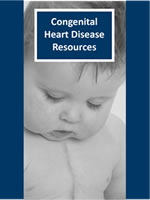Children and Youth with Special Health Needs (CYSHN)
Programs
Contact Info
Ebstein's Anomaly
Condition Description
Ebstein's anomaly is a defect of the heart that occurs early in fetal life when the right pumping chamber (ventricle) and the valve (tricuspid valve) in that chamber do not correctly form during fetal life, for unknown reasons. The tricuspid valve is abnormally located low in the right atrium, and it may not have a normal structure or function correctly. The right atrium is larger than typical and has thinner walls, and the right ventricle is smaller than usual.
Some children have this condition diagnosed as infants, and in other children it is not detected until they are adolescents or even adults. Ebstein's anomaly may be very mild, causing no symptoms and needing no treatment. If it is more severe, there may be blockage of blood flow to the pulmonary artery, the large vessel that leaves the right side of the heart to take blood to the lungs to be oxygenated. A blockage can cause the child's blood to have lower than a normal oxygen level, in which case the child's skin will have a grayish-blue color, especially around the mouth and nose (called cyanosis)
Many children with Ebstein's anomaly will have no symptoms, so no treatment will be necessary. If the valve is leaking or is narrowed, symptoms could make treatment necessary. Surgery is sometimes necessary either to repair or to replace the tricuspid heart valve so that blood flows readily to the lungs to receive oxygen.
Long-term, children with Ebstein's anomaly will need to be followed at least yearly by a cardiologist to be sure that there are no new symptoms that require treatment. Chest x-rays, electrocardiograms and echocardiograms are typical tests that may be periodically necessary.
Individuals with this condition will require antibiotics when they have dental procedures throughout life because mouth bacteria can be released into the blood stream and set up an infection in the heart (endocarditis) when there is an abnormality in a heart wall or vessel.
Our program has been tracking Ebstein's anomaly among live births in select counties since 2005 and have expanded statewide.
- Using data from births to Hennepin and Ramsey county residents between 2012-2016, we found that fewer than 1 baby was born with Ebstein anomaly per 10,000 births.
- Using this data, we estimate about 3 babies are born with Ebstein's anomaly every year in Minnesota.
